
It’s been a good few months for UK bond investors. The yield on the benchmark ten-year gilt dipped below 1% last week, a level last seen in October, says Kate Allen in the Financial Times (bond yields fall as prices rise). US and German yields haven’t fallen as far, implying that markets are “flagging a deteriorating outlook for the UK economy as the country negotiates Brexit”.
As for short-term political factors, it’s interesting to note that “whatever outcome you expect [of the snap general election], you get the same result”, Marcus Ashworth points out on Bloomberg. “Comfortable majority for Theresa May, yields dip. Polls tightening on signs that Labour Party leader Jeremy Corbyn might be less hopeless than thought, yields dip… hung parliament, yields dip.” A large majority for the Conservatives is seen as a positive prospect for gilts, since it should give May more room for manoeuvre in Brexit negotiations. On the other hand, gilts’ status as a haven asset makes them appealing if Corbyn prevails.
But gilts will have to get off the fence once the vote is over. The new government’s spending plans, future inflation expectations and Brexit negotiations will all affect valuations. “Sub-1% ten-year yields may not stand up to those headwinds for too long,” Ashworth says. The key point, reckons Jonathan Loynes at Capital Economics, is that the market seems too pessimistic about Brexit and the nearer-term economic outlook. “Market rate expectations [imply] that the first quarter-point hike won’t arrive until well into 2019.” But if the economy proves resilient in “Q2 and beyond”, as the indicators suggest, interest-rate expectations and gilt yields “are likely to rise accordingly”.